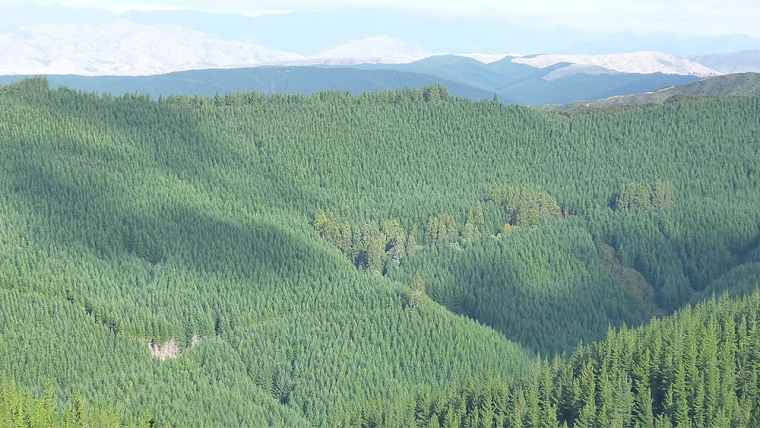
A key agricultural lobby group says a lot of farm land has disappeared into forestry and some more could still do so against the intent of legislation meant to stop it.
There is also concern that many forestry conversions have been rushed through at the last minute, in the manner of drivers who accelerate as traffic lights turn orange, in order to beat the red.
The complaints come from Beef + Lamb New Zealand (B+L NZ), and follow legislation introduced on Tuesday to inhibit forestry conversions, which had been foreshadowed in announcements made last year.
“While we appreciate the Government’s announcement this week about legislation to restrict wholesale conversions based on land use classes, the numbers show whole-farm sales for conversion to forestry for carbon credits are continuing at pace,” says B+L NZ Chair Kate Acland.
“Anecdotally we’re still hearing of a significant number of farms being sold this year, despite the Government announcing the limits last year.”
B+L NZ and other farming groups have long complained of farmland being swallowed up by forestry, which they say can turn small agricultural communities into ghost towns. They say that when forests replace farms, workers are no longer needed for the daily toil of farm life, which deprives the local pub, shop and garage of customers.
This has been countered by forestry industry leaders, who say that when they purchase farms, they offer people a way out of farming as they get older or if they want to switch occupation. In addition, trees soak up CO2 and thereby combat climate change.
But the Government has largely sided with farmers, and introduced legislation this week to inhibit forestry conversions. This legislation follows up on announcements made last year.
The legislation looks at the eight official classes of land in New Zealand, from Land Use Capability One (lush cropland) to Land Use Capability Eight (erosion-prone mountains or steep hill country). It decrees that classes one to five cannot take part in the Emissions Trading Scheme, which would affectively stop forestry companies from buying this land for conversions.
The legislation allows conversions of Class Six land but limits this to a total of 15,000 hectares per year, most of which would be allocated on the basis of a ballot starting next year.
Acland questions whether this week’s legislation goes far enough.
“In particular Land Class Six is the foundation of our breeding farms and 15,000 hectares every year coming out of this will add up over time.
“Our sector wants to be able to get on and further grow exports, not spend time worrying about this issue.”
The legislation backdates the starting point for the rules to last December, but allows an exemption where afforestation was well underway before then. But there are fears that this could offer a loophole to forestry companies, because of debate about the degree of intent shown by companies to actually start an afforestation in the years leading up to seedlings actually being put into the ground.
“We’re concerned that some sales are continuing on the basis of intent to purchase land before the limits were announced,” Acland says.
“We urgently need the Government to tighten the criteria around proof of intent to purchase.”
B+L NZ adds figures from research commissioned from the consultancy, Orme & Associates, show sales in 2023 now total 29,518 hectares and sales in 2024 are 30,483 hectares. And the final figure is expected to rise as further sales are confirmed.
“The total amount of whole sheep and beef farms sold since 1 January 2017 is now more than 300,000 hectares……. more than two million stock units have been lost to afforestation since 2017,” Acland says.
The B+L NZ comment follows data highlighted last week by Westpac economists, showing the amount of land available for farming has fallen from 15.6m hectares in 2002 to 13.1m hectares in 2024. In addition, the number of farms in operation has fallen even faster.
At the same time output has risen slightly, indicating good productivity gains in the farming sector. But Westpac’s agricultural economist Paul Cark says a lot of this growth is due mainly to dairy industry improvements, and he is urging farmers in all sectors to work hard to improve their productivity.
This is important since the high global prices for New Zealand farm exports right now might not last.
Meanwhile the spread of pine trees to soak up greenhouse gases – so-called carbon farming - does not get a clean bill of health across the economy. Many environmentalists have called for reduced carbon emissions at source, not by using trees to soak up CO2. That is because those trees could later fall victim to forest fire, or disease or insect attack, killing them and releasing dammed up carbon into the atmosphere.
2 Comments
'That is because those trees could later fall victim to forest fire, or disease or insect attack, killing them and releasing dammed up carbon into the atmosphere.'
No it isn't. If environmentalists are saying that, they should be challenged.
It is because you cannot ADD underground-stored carbon to the above-ground arena, without altering the chemistry - and therefore the physics and biology - above ground.
And it being energy that we extract it for, and energy which would be required to do any sequestering, we have chosen not to sequester.
Also, given that fossil fuels represent historical sunlit acres, the replacing of their energy with real-time sunlit acres is why we are seeing growing competition for them. That is global and local.
The area calcs are here: http://www.withouthotair.com/
Aussie and California spent trillions on carbon virtue signally gravy trains. Any carbon "saved" in the previous two decades went up in smoke because they forgot to do unsexy things like prescribed burning. If only the trillions had been spent on some nuclear power plants. http://www.withouthotair.com/
"In this short communication, we estimate that California's wildfire carbon dioxide equivalent (CO2e) emissions from 2020 are approximately two times higher than California's total greenhouse gas (GHG) emission reductions since 2003."
https://www.sciencedirect.com/science/article/pii/S0269749122011022
2020 bushfires smoke out 7 years of aussie anthro carbon emission.
https://www.nature.com/articles/d41586-021-02509-3
Had They Bet On Nuclear, Not Renewables, Germany & California Would Already Have 100% Clean Power
https://www.forbes.com/sites/michaelshellenberger/2018/09/11/had-they-b…

We welcome your comments below. If you are not already registered, please register to comment
Remember we welcome robust, respectful and insightful debate. We don't welcome abusive or defamatory comments and will de-register those repeatedly making such comments. Our current comment policy is here.